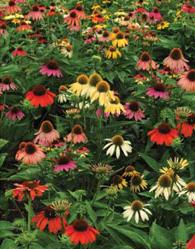Welcome to our perennial plant nursery!
Imagine More Perennial Plants Than You Can Imagine,
Delivered To You with Free Shipping to most states.
Shop by Category
Shop by Brand
Shop by Brand
Echinacea
 Echinacea (ek-in-nay-shee-uh), Coneflowers, are not just purple coneflowers anymore, but a wide range of flower colorations consisting of various hues of magenta, orange, pink, purple, white, and yellow. There are also numerous flower types available including single, double, quilled, or cultivars with bi-color blooms or petals that changes color over time.
Echinacea (ek-in-nay-shee-uh), Coneflowers, are not just purple coneflowers anymore, but a wide range of flower colorations consisting of various hues of magenta, orange, pink, purple, white, and yellow. There are also numerous flower types available including single, double, quilled, or cultivars with bi-color blooms or petals that changes color over time.
Native to North American, purple coneflower was once common in meadows and prairies and is often used in summer gardens to attract butterflies or for use as a cut flower.
Coneflowers like it sunny and hot. Plant in sun to partially shady sites. Morning sun and afternoon shade often yield the best looking flowers. Light, loamy soils are best, but coneflowers will grow in any well-drained soil. Once established, they are quite drought tolerant.
Use in mass or group plantings, borders, entrance ways, back of the perennial bed, and naturalized areas or woodland edge. Fragrant flowers attract butterflies. Spent blooms should be left on the plants in fall because seeds provide winter food for finches and other birds. Deer resistant.
